Love it or hate it, Valentine’s Day is coming this weekend. And with all the usual options off the cards for most of us (thank you, coronavirus) it looks like a movie night in is one of your best options the big romantic day.
This got the team at Casino.org chatting about romantic movies, as well as iconic kissing scenes that make us swoon – and the ones that make us cringe. What is it about watching characters with zero real connection that makes us curl our toes?
We wanted to analyze which on-screen kisses have the most chemistry behind them, so we decided to take a look at three of the key criteria behind a good kiss, and rate some of the most iconic kisses in film against them.
To do this, we teamed up with Patti Wood, an internationally recognized nonverbal communication and human behavior expert. She has conducted years of research in the field of human behavior, so was the ideal person to help us on our quest to find the best and most awkward kisses.
Patti Wood watched hours of iconic kissing footage and rated them on how ‘fully present’, ‘mutual’ and ‘natural’ they were (descriptions at the end).
Using her expertise, she analyzed body language to determine a score out of five for each category and provided detailed analysis on each of the iconic kisses. We then combined the scores to reveal a ‘total chemistry score’.
Which On-Screen Kisses Really Had The Most Chemistry?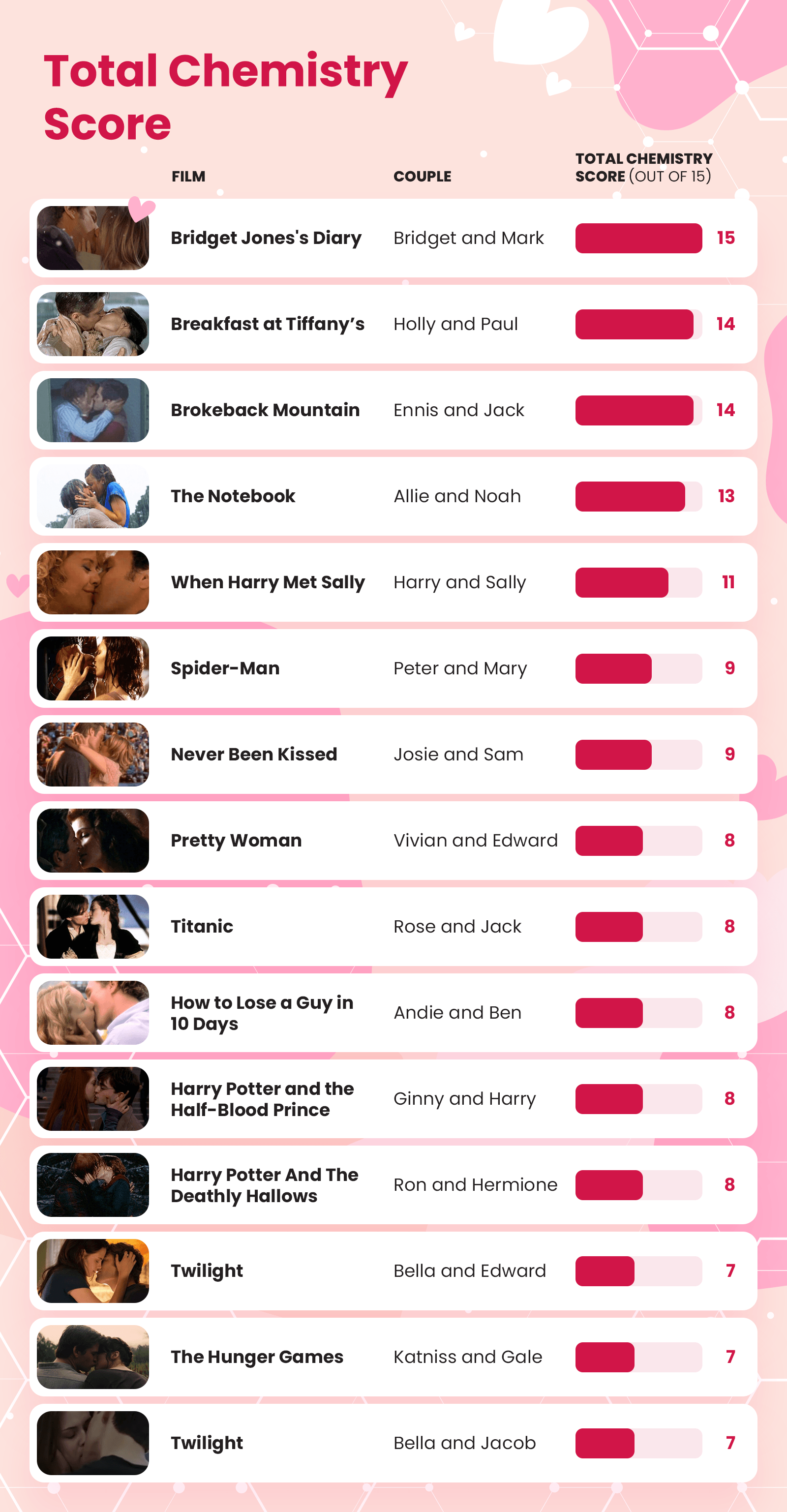
Out of all the couples analyzed, the two that came out on top with the most on-screen chemistry were the iconic Bridget Jones and Mark Darcy, played by Colin Firth and Renee Zellweger.
After 32 years of living in a “permanent state of spinsterhood” Bridget finally found her prince charming in one of the most iconic on-screen kisses of all time.
We all love that moment in the movie, but why exactly is that?
As well as the fact you’ve been rooting for Bridget throughout, Patti Wood explains that it’s also got a lot to do with their body language:
“When they kiss, there is lovely “presentness” if I can make up a word. We actually see them go from being aware they are on the street and being watched to blocking all that out so it’s only the two of them.”
“It goes back and forth on who is initiating and doing the work to make the kiss happen but when they kiss he wraps his arms around her, and she again crosses space to go to him, stands on her tip toes and throws her arms around him.”
“It’s the perfect combination of tender sweetness, and then they get hungry for each other. I love how they linger together in the embrace. It indicates symbolically that this kiss will escalate into more and that they will stay with each other.”
So as our expert explains, it’s all about the way the two were present, the back and forth, the embrace, the type of kiss and how it developed.
That’s a whole lot of stuff going into one kiss – no wonder it’s so iconic.
Category One: Fully Present
As mentioned, the analysis was broken down into three main categories. The first one was ‘fully present’ and was scored out of five.
Patti Wood explained that fully present means that both people are focused on each other and that the rest of the world melts away or disappears.
She used her expertise to analyze body language in the scenes to assess just how into the kisses the characters really were.
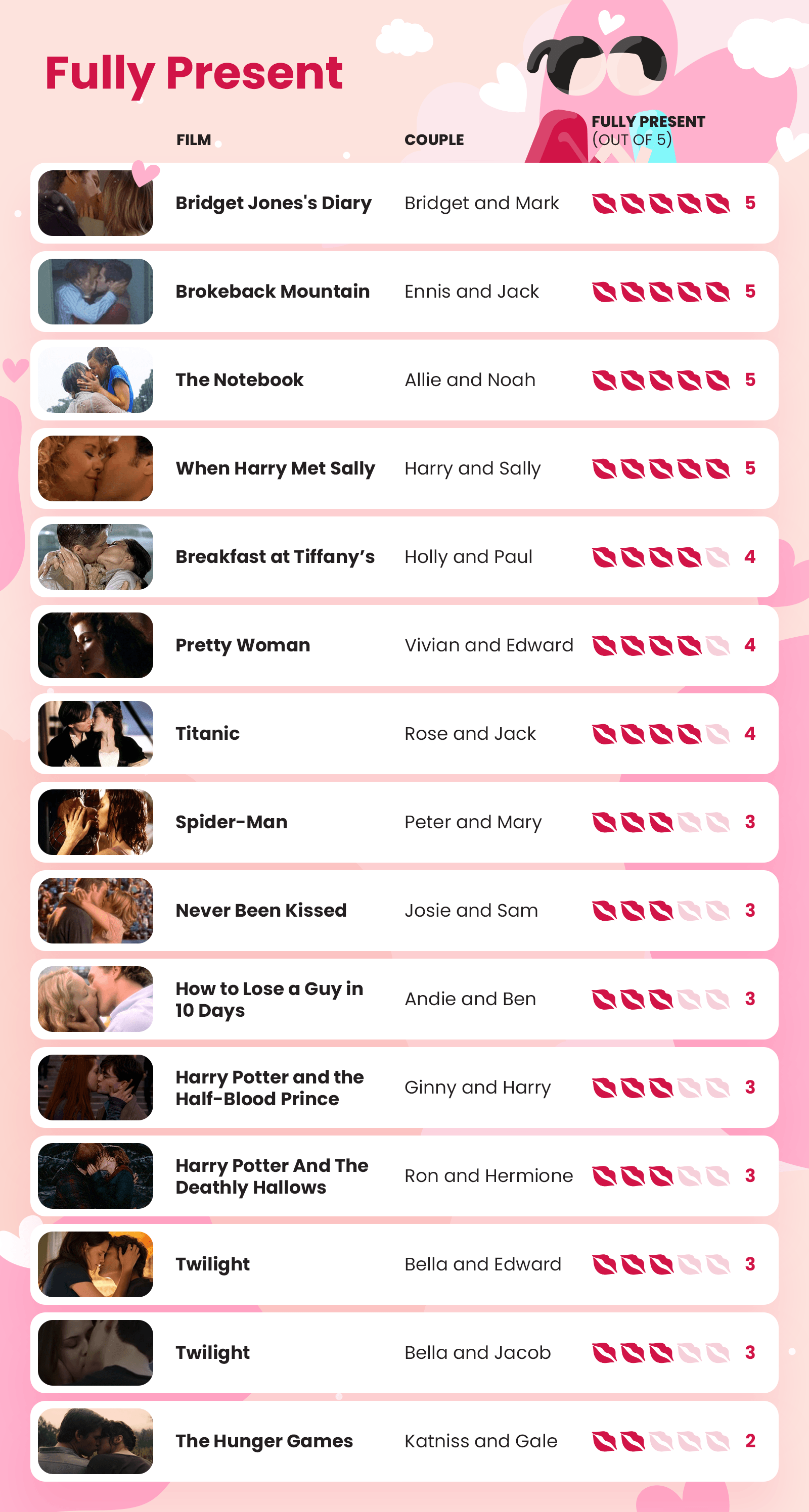
There was a tie of four front-runners when it came to being fully present in their big kissing scenes: Bridget Jones’s Diary, Brokeback Mountain, The Notebook, and When Harry Met Sally.
The couples in the scenes were able to ignore any chaos which might have been surrounding them, to fully focus on their partner during the kiss.
Let’s dig deeper into Patti Wood’s analysis to see the behavioral signs that made the couples’ kisses a winning or losing moment in this category.
Brokeback Mountain (5/5)
“The rest of the world doesn’t matter, made even more obvious by his wife seeing them kiss and them being oblivious to it.”
“We see a wide range of emotions and body language. We see a hug, a thrust and pushing across a across a great space, a collar hold, a passionate kiss, then they look deeply into each other’s eyes and hold each other to show they love each other before he turns and walks away.
“All saying nonverbally: I desire you, passionately and I love you, but I am denying it.”
The Notebook (5/5)
“Notice how their faces are touching. There is only them, the rest of the world doesn’t matter.”
“Even the reality of the fierce rain pelting them doesn’t affect them.”
The Hunger Games (2/5)
“We see them sit sideways, not turn their bodies fully toward each other and not look deeply into each other eyes. In fact, he avoids eye contact and even looks down.”
Category Two: Mutual
The second scoring system for our kissing criteria was mutuality.
It’s incredible how many kisses in movies are initiated or given by one person making all or most of the effort. The most romantic kisses are those that are mutually given and received.
So out of all our selected iconic kissing scenes, how many of them displayed body language that showed they were one-sided?
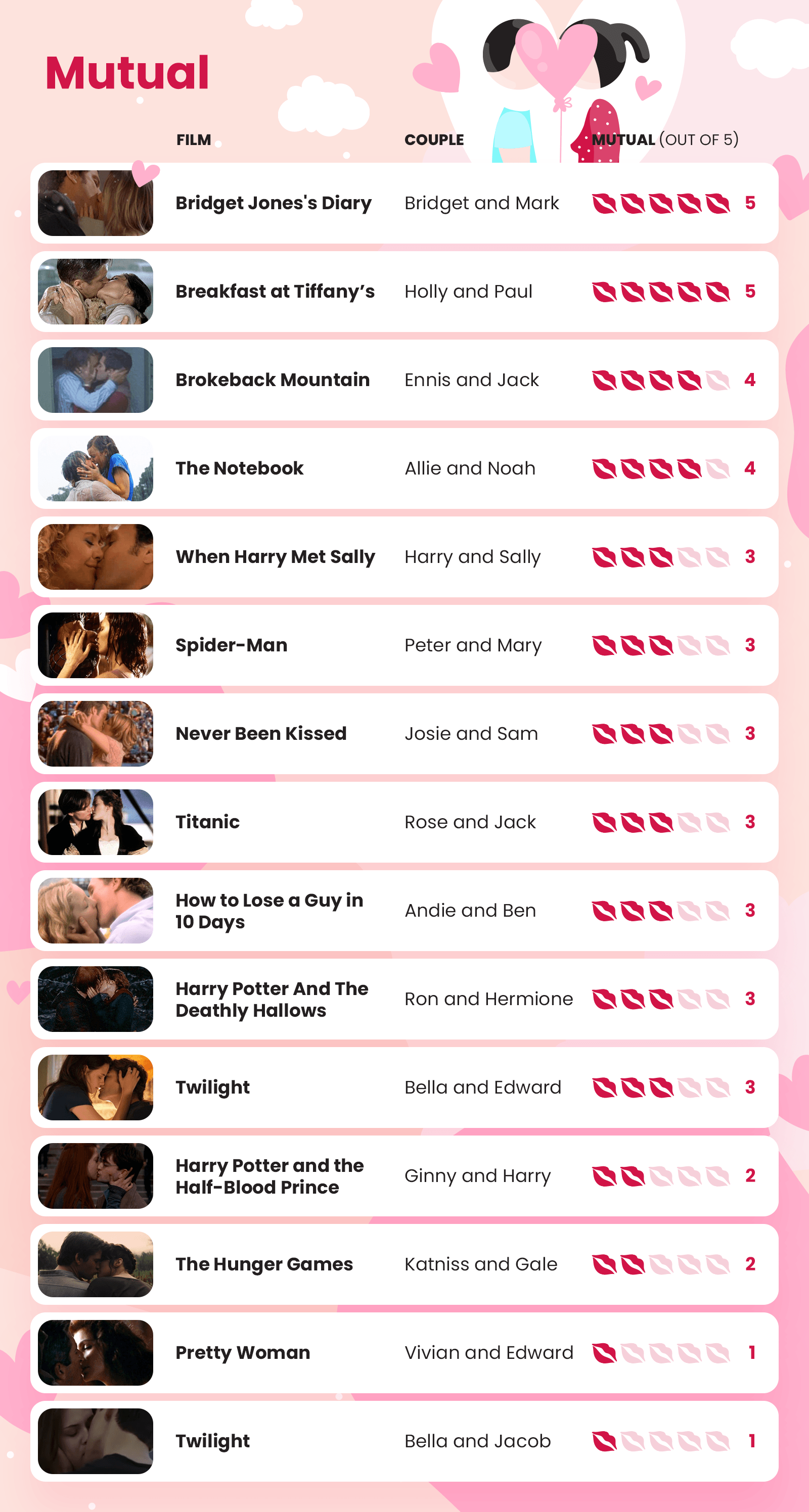
Here’s what our body language expert had to say about some of the scenes.
Breakfast at Tiffany’s (5/5)
“So good. He comes to find her, but she crosses the divide to come up to his still form. Then he reaches out and draws her in – and even her cat in.”
“I love how they both wrap around each other and push their faces into each other and really smooch together. Look at how her fingers reach out and around him.”
Twilight: Jacob and Bella (1/5)
“I would almost give this a 0, but there is moment before she is repulsed and hits him, where we know she is making a choice and is present for that moment before she makes it.”
Pretty Woman (1/5)
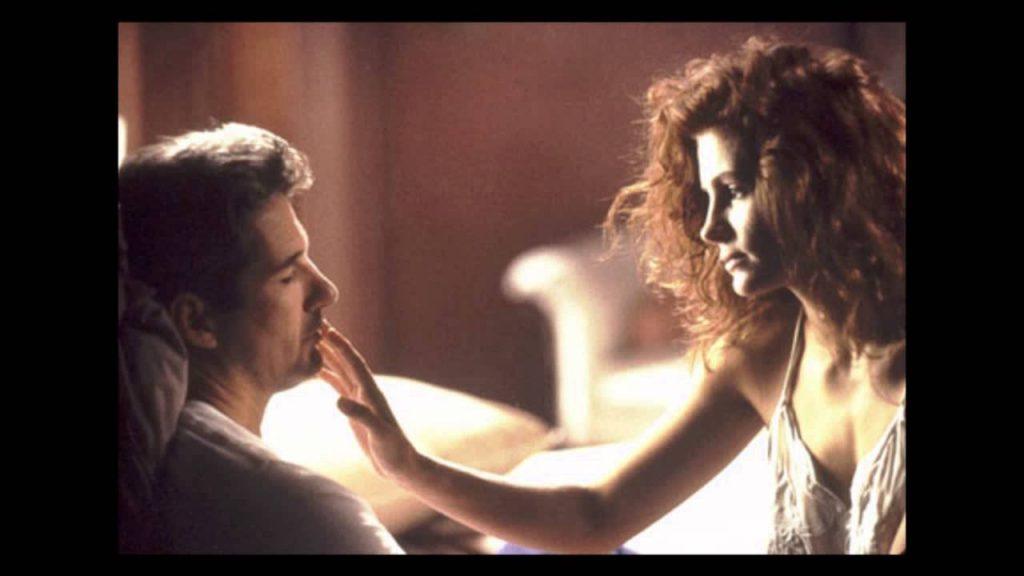
“I think that if we are looking again at the initial kiss on her finger to his mouth, it’s all about her giving the kiss.”
Category Three: Natural
The third factor that Patti Wood was assessing was how natural the kisses were.
To score highly here and appear natural, a movie kiss needed to look like it was a real kiss between real people and not overly done or manipulated.
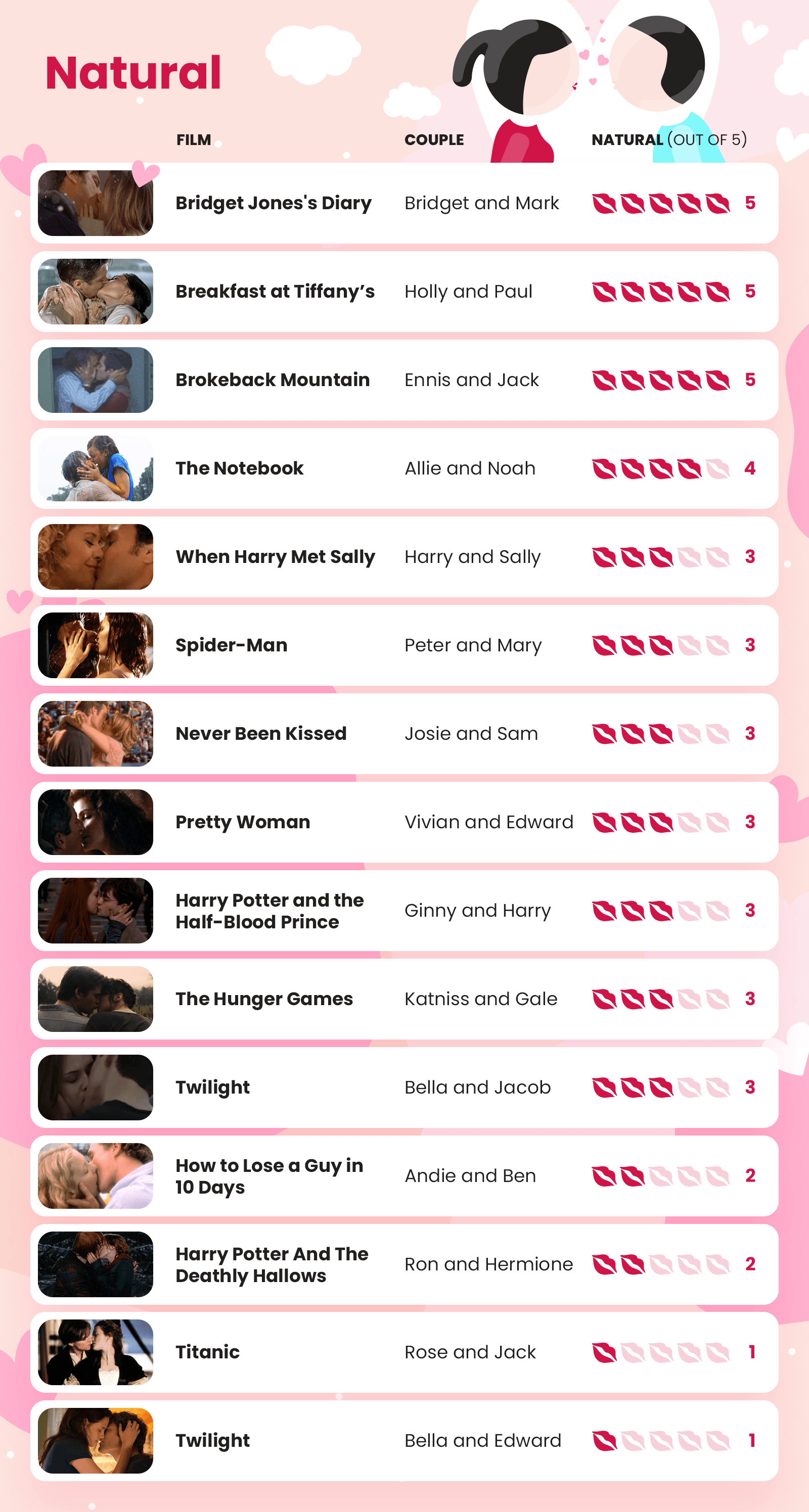
Here’s what she had to say:
Brokeback Mountain (5/5)
“You have the animal passion and ferocity and the tender holding and eye contact. There is not artifice at all. It’s a raw kiss.”
Bridget Jones Diary (5/5)
“Even though it checks the boxes on a Hollywood romantic kiss, the way they look at each other before during and after the kiss and how the kiss change and continue is very much like a real kiss.”
Titanic (1/5)
To us, this kiss just looks SO impractical (hello, sore neck), but Patti Wood noted there is a whole lot more we can analyze in the kiss.
The heavy symbolism takes away from the natural elements of the kiss:
“She is fully vulnerable to him. She actually put her arms out and stands like she is letting herself be crucified – that very heavy religious symbolism – and she could actually die falling off the bow of the ship.”
“In this case she and the audience know that what she is doing physically is risky, and it matches with the relationship and life changing risk she takes in kissing him and not her rich finance and the security of that relationship.”
Methodology & More Information About Patti Wood’s Scoring System:
Fully Present
This means that both people are focused on each other and that the rest of the world melts away or disappears. If there are other people in the scene, the characters are unaware of them or don’t matter.
If there are physical barriers, they overcome them, which makes elements like rain or snow that are overcome in kissing scenes more powerful. Occasionally, the kissers bring nature into the kiss to make it even more exciting and powerful.
It typically means that there is mutual eye contact and the front of the bodies – what I call the body windows of the toes, knees, pelvis, stomach, palms of the hands, neck, mouth, and eyes – are facing the other person and or are touching. There are exceptions, such as when the one kisser is leaning back on the other, like in the Titanic kiss.
Mutual
It’s incredible how many kisses in movies are initiated or given by one person making all or most of the effort. That doesn’t make them less magical on-screen; it’s just a different kind of kiss.
Since I critique the kind of kisses that most would like to be giving and getting, I think a kiss that is mutually given and received is super romantic.
It’s all so interesting as the initiator is seen as having the most power and control. In many movies, the superhero or man or woman with the most power can have the power dynamic changed by another character immobilizing them in some way – by being the initiator.
Mutual kisses mean both people want the kiss, and typically, they both have their mouths the same way inside the kiss. If one is touching or holding the other, the other one is too.
Natural
This means that the movie kiss looks like it is a real kiss between real people, not overly done or manipulated.
That may mean we see a natural progression that builds to the kiss, that may mean that we see the intense passion and the character open up or fling themselves at each other in a primal way.
One of the things that makes a kiss natural is that there is something happening in the silence between the characters.
That may be eye contact or emotion playing on one or the other’s face, or simply a felt tension before, and a release after.
I often watch the kiss without the sound on several times to make sure that the music is not influencing my read of the kiss.
Other Terms
Our expert refers to some of the kisses analyzed as passionate, fiery, sweet, tender, and other adjectives.
Although we know what the words mean, the types of kisses tend to fall into a ‘heat’ or ‘sweet’ category, and there’s a scale of the types in-between.
Below our expert explains more about how it works and where the main differences lie.
Heat
This means that the body language is passionate, so that you can tell that the “kissers” can’t resist each other. That may mean that a passionate kiss goes from still to one or both people moving swiftly across space to be with one another and leaping, clinging, and opening body windows to each other.
This can be seen in the open mouths offered in The Notebook and Breakfast At Tiffany’s kisses – clinging in a primal way.
Sweet
This is when we see a slow pace that allows one person to draw in the other or court to the kiss.
There may be a look then look away eye contact, a touch, or asking for permission before the kiss. Or it could be the initiator watching and waiting until the other is ready before a kiss.
Smiling by one or both characters can make it extra sweet, along with a mutual look at each other in the eyes. I think that the eye-to-eye gaze just before a kiss and/or just after the first kiss is very telling.
Heat tends to come when the intimate eye-to-eye gaze goes to a quick passionate meeting of mouths. The sweet kiss is preceded by one character looking and the other bowing their head, or tilting their head or looking away.
Many of these movie kisses play against the normal eye gaze that preceded the kiss, by having one character close their eyes and trust the other person.


